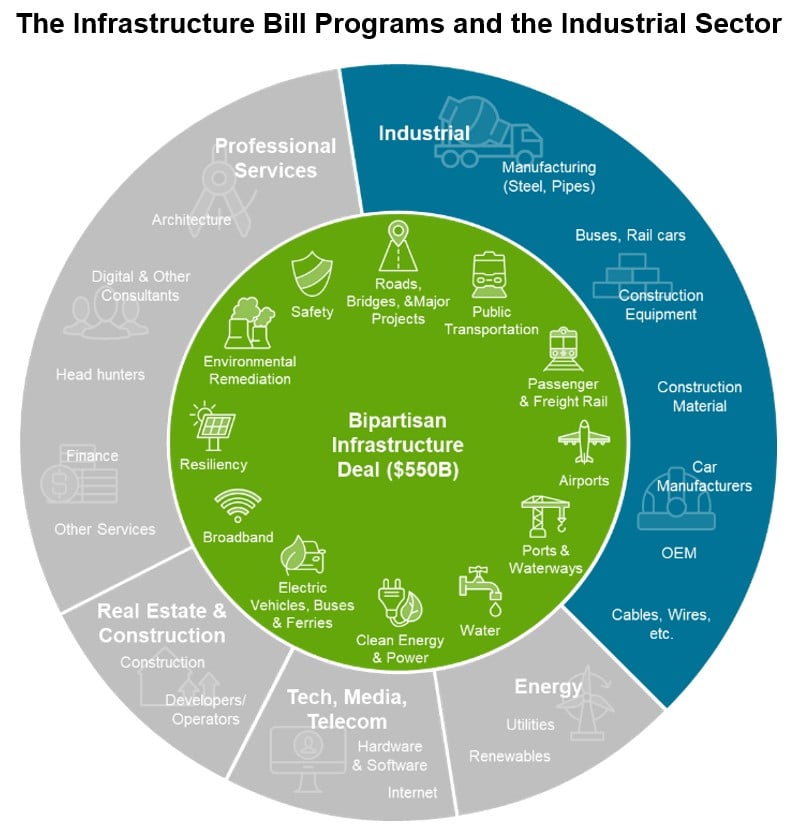It’s been well over a year since the $1.2 trillion Infrastructure Investment and Jobs Act (IIJA or the Infrastructure Bill) was passed into law, with a five-year allocation of $550 billion in federal investments in America’s infrastructure to upgrade highways and major roads, bridges, airports, ports and water systems.
As of May 2023, according to the White House (2023), over 20,000 projects have been awarded more than $200 billion from the IIJA. There are still funds available for industries that want to invest in IIJA programs. For a list and breakdown of IIJA programs that you can capitalize on, read our previous article.
The funds have started to flow to the various states, so now is the time to take advantage of this once-in-a-generation investment that provides America’s infrastructure with the continuity and stability that are crucial to meeting our future needs.
Industrial Sector Likely the Biggest Beneficiary
As shown in the illustration below, the IIJA will substantially impact industrial manufacturers widely focusing on seven subsectors: water; roads, bridges and major projects; public transportation, airports, ports and waterways; passenger and freight rail; electric vehicles, buses and ferries; broadband; and resiliency.

Important Steps
Funding from the IIJA is regulated by various federal agencies that use a federal-aid formula based on multiple factors at the state level, with local agencies driving each project. Local agencies will solicit a request for proposal (RFP) for companies to execute IIJA-funded projects. Those RFPs will include the Key Performance Indicators (KPIs) for the executing company to meet the requirements outlined in the agency’s business case.
A critical first step for a company interested in being a vendor to the government is to get the relevant approvals that permit your organization to sell products and/or services to the U.S. and state government. These include:
- GSA: This is the General Services Administration (GSA), which is a federal-level approval. Many states and local governments allow for purchase of goods and services off GSA Schedules.
- State Term Contracts/Convenience Contracts: Then, the organization must obtain approval for selling relevant goods and services for each state they want to work with. Some large local governments have their own term contracts/convenience contracts. Some regions have cooperative arrangements in which lead local governments run solicitations that allow the others to purchase off the resulting contracts (DC region, etc.).
- National Procurement Vehicles: Be on National Procurement Vehicles in which state and local governments lead solicitations with the resulting contracts available nationally to state agencies and local governments able to procure off them based on state and local procurement laws, such as National Association of State Procurement Officials (NASPO ValuePoint, Omnia Partners and BuyBoard).
- Other: Depending on specific grant opportunities, there may more specific opportunities to seek funding.
Once the approvals are received, your organization can initiate the competitive bidding process for contracts.
Then, each organization would need to assess its own market and business situations to determine if it is positioned to meet the huge surge in demand, as market headwinds persist. Macro issues facing the industry include rising interest rates, continued supply chain challenges, market uncertainty and a potential, looming recession. Simultaneously, your organization will have to determine if its business operations would be able to meet the increased demand, if it has the right quality and quantity of talent, and the enabled technologies to support business growth. Leadership will need to develop tangible strategies and action plans to take advantage of the increased investment.
Understanding and Obtaining IIJA Funds To Optimize Your Business
At Cherry Bekaert, we are committed to working with you on your journey to help you understand the IIJA funding, identify funding opportunities to apply for and guiding you through the complex process of seeking approval for your infrastructure projects.
To take advantage of the funding, you must adopt a holistic approach to identify operational improvements. We equip a design-thinking approach to turn insights into tangible results by helping you:
- Re-examine Your Market:
- Conduct an “outside-in” analysis.
- Re-examine business factors.
- Identify shifts in customer needs.
- Re-assess Your Business:
- Perform an “inside-out” analysis.
- Calculate scale of taking advantage of the funding.
- Determine your go-to-market approach.
- Review business operations.
- Re-engineer Your Business:
- Streamline your business operations.
- Assess if your organization’s current technology infrastructure could handle the increased workload, and if not, identify actions needed to upgrade the technology infrastructure.
These are just a few important elements that states consider when deciding whether to allocate funding to your project. It’s important that you strongly emphasize why you are deserving of the funds.
Despite these challenges, there are ample opportunities for companies who qualify for funding. Overall, the IIJA can help improve the competitiveness and resilience of industrial-led efforts, create more jobs, and advance productivity and economic growth.
Get Started Now
To determine actions needed to optimize your business to take advantage of the Infrastructure Bill funding, Cherry Bekaert has the knowledge and the capabilities to help you throughout the entire process. Your journey will be unique, and we are here to guide you forward.
Sources:
Investing in America. The White House. https://www.whitehouse.gov/build/.
Maps of Progress. (2023, May). The White House. https://www.whitehouse.gov/build/maps-of-progress/.



